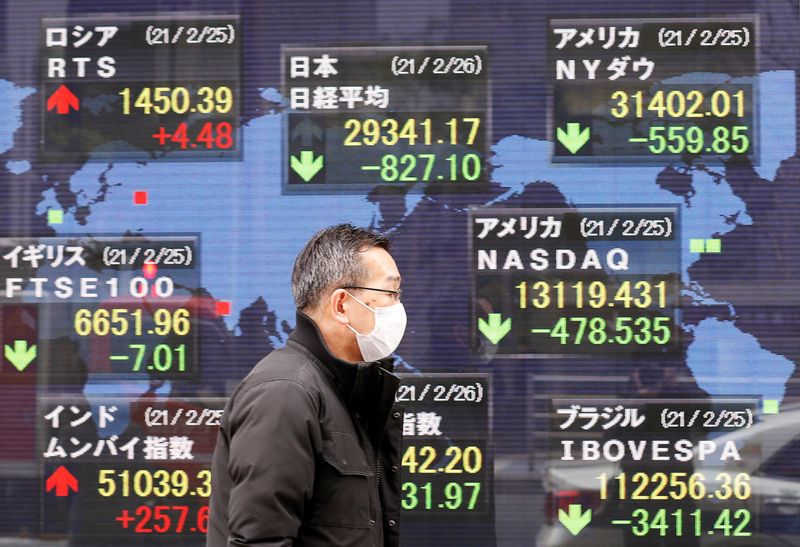By Jamie McGeever
ORLANDO, Fla. (Reuters) -Remember 'Japanification'?
After the financial crash of 2008, a consensus emerged that the United States and Europe would slide into the sort of multi-decade economic malaise Japan experienced after its property bust of the 1990s - where the effects of a rapidly ageing population saw waves of excess savings, slow growth and persistent deflationary pressures.
Termed 'Japanification', the diagnosis involved chronically low or negative interest rates and bond yields, with repeat bouts of bond-buying 'quantitative easing' and mounting debt piles.
When COVID-19 hit, many doubled down on that view.
And yet inflation in the United States and Europe has surged to its highest in four decades.
Initially dismissed as transitory due to the bottlenecks and base effects of the post-pandemic reopening, price rises are proving more durable and pervasive than central banks had hoped and many are already lifting interest rates.
An energy price shock since Russia's invasion of Ukraine compounds the problem. And U.S. Treasury bonds have had their worst quarter in at least 25 years.
So is the 'Japanification' thesis now dead?
Steve Major, head of global fixed income research at HSBC, says it's very much alive, and offers three broad reasons: the Fed's own recent 'dot plot' projections, current market pricing, and the long-term structural drivers that existed before 2008.
Federal Reserve policymakers this month raised their median projection of where they see rates peaking to 2.8% next year from 2.1% in 2024 as per their December forecast.
This is well into 'restrictive' territory - defined as rates above the Fed's assumption of long-term neutral rates - and increases the chance of a recession that will probably see rates and bond yields quickly come back down again.
Several measures of yield and rates curves - nominal, real, and forward - back up this view.
Crucially, Fed policymakers also lowered their longer-term neutral rate forecast to 2.4% from 2.5% where it had been since 2019. This is no rounding error, but a result of three policymakers lowering their long-term outlook.
The Fed is essentially indicating that the long-term trend for the neutral rate of interest is still downward because the economy is not strong enough to withstand higher rates.
Ultimately, the deflationary pull exerted by huge and rising debt levels, ageing populations, high degrees of wealth inequality, and rapid technological advances is strong.
"These trends are very powerful and are things that the central bank has no control over. Can the central bank control how old people are?," Major says, adding: "The 'lower for longer' hypothesis is intact. And the market at the moment supports it."
R-STAR ZERO
The pandemic has cast some doubt over the long-held view that ageing and related worker shortages over time are as deflationary as Japan's experience suggests.
The most powerful of those arguments - outlined by economists Charles Goodhart and Manoj Pradhan just before the pandemic - is that worker shortages will ultimately lift the bargaining power of labor and wages and help reflate prices more generally.
But demographics are a double whammy for interest rates in the long term. Ageing populations and shrinking workforces cut potential growth rates over time while workers nearing retirement typically bank life savings into safer bonds.
Bouts of inflation and rising bond yields are possible, as we are seeing now, but they are less likely to last.
Curiously, one of the Fed's most hawkish rate-setters revealed that the Fed still agrees with the 'lower for longer' outlook.
St. Louis Fed President James Bullard dissented against the Fed's 25-basis point rate hike to a 0.25%-0.50% range on March 16, and voted for a 50 bps increase. He has since called for rates to rise beyond 3%.
But he also sees the long-run equilibrium policy rate at 2%. Assuming the Fed brings inflation back down to its 2% target, that implies a real policy rate, known as 'R-star', of zero.
Estimates of R-star vary and the Fed's median estimate is now 0.4%, so zero would not be a total surprise. The New York Fed stopped updating its estimates in 2020 due to the pandemic, but the long-term downtrend is clear.
Albert Edwards at Societe Generale (OTC:SCGLY) has been a long-term bond bull for the all these structural reasons, correctly calling the decline in yields and interest rates as part of his 'Ice Age' view of the global economy and markets.
He thinks a thaw is eventually coming, and thinks inflationary pressures from soaring commodity and energy prices, fiscal largesse, and expanding deficits will overwhelm and crash the bond market.
But despite the scramble to re-price bonds amid the central bank hawkishness of recent months, this quake is still not the big one.
"This isn't the end of the bond bull market in the near term. This spike in commodities will ultimately be deflationary and will kill global demand," Edwards said, adding: "The Fed is going to tighten until they put the economy back into recession, and that won't take very long."
Edwards reckons the 10-year Treasury yield can revisit its record low from August 2020 around 0.5%, a level historically associated with Japanese yields.
(The opinions expressed here are those of the author, a columnist for Reuters.)
(By Jamie McGeever; Editing by Andrea Ricci)
